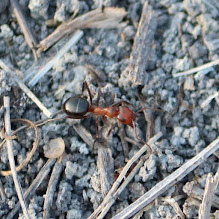It did not take a very close inspection to see the mound was alive with activity: hundreds of ants hauling, pushing, carrying twigs, leaves, bits of plant material or dirt. They were handsome ants, with shiny black abdomens* and russet heads, with the antennae rakishly cocked. Their activity was mesmerizing; so many ants, doing so many things!
From photos, iNaturalist helpfully suggested they belonged to the genus Formica ("Wood, Mound, and Field Ants"--that certainly made sense), with further suggestions narrowing the species to the Allegheny Mound Ant, Formica exsectoides.
 These ants will construct mounds above ground, with tunnels throughout and extended below the ground's surface. Each colony can have several queens taking care of the reproductive aspects of the colony, with workers doing the construction, maintenance, and care. The large mounds above ground are thought to take advantage of the warmth of the sun to keep their nurseries--the eggs and the larvae--warm and also allow an early start in the spring as the mound may stay warmer than its surroundings.
These ants will construct mounds above ground, with tunnels throughout and extended below the ground's surface. Each colony can have several queens taking care of the reproductive aspects of the colony, with workers doing the construction, maintenance, and care. The large mounds above ground are thought to take advantage of the warmth of the sun to keep their nurseries--the eggs and the larvae--warm and also allow an early start in the spring as the mound may stay warmer than its surroundings. The worker ants will forage outside the nest, hitting up extrafloral nectaries such as those on Partridge Pea, as well as honeydew from aphids. They will also hunt other arthropods, and in defense of their mound they can bite ferociously while also producing painful formic acid as an added deterrent.
The mound colonies can persist for years, and additional mounds can be established nearby as colonies split off.
Who knew there was a little ant city going about its business right next to the trail?
Sources/Additional Resources:
- Tiny camera explores ant colony
- AntWiki: Formica exsectoides
- BugGuie: Species Formica exsectoides - Allegheny Mound Ant
- Wild About Ants: Allegheny Mound Ants, Formica exsectoides
*I discovered that ant anatomy is a bit more complex than the basic insect anatomy I'd learned about: this hindmost part of an ant is technically called the "gaster", which, along with the narrow "petiole" that connects it to the forward parts of the body, comprise the "metasoma". The abdomen consists of segments, the first of which in ants is actually fused to the thorax; the petiole is the second abdominal segment, and the gaster includes the remaining abdominal segments.

